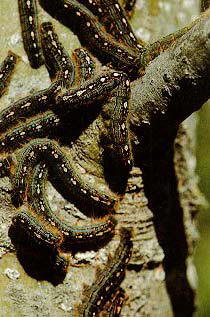
Importance: Periodic outbreaks of the forest tent caterpillar (Malacosoma disstria) cause serious defoliation of hardwoods, particularly oaks and gums. It has repeatedly defoliated hardwoods in the Mobile and Tensaw River bottoms of southwest Alabama for many years. Since 1965, the average defoliation was 30,000 acres with a steady increase yearly. In an epidemic, trees with repeated defoliation are sometimes killed, but the major damage is in growth losses. Larvae occasionally create a nuisance in recreational areas.
Identification: The adult moth is light brown with a wingspan of approximately 1¼ inches. Forewings have one broad or two thin parallel dark brown lines in the center. Grown larvae are about 2¼ inches long, dark bluish with yellow lines extending along each side of the body, and keyhole or diamond shaped white spots down the middle of the back. Pupae are reddish-brown and the cocoon is formed in loosely rolled leaves. Eggs are laid around the twig in masses of as many as 300, covered with a dark-colored secretion that hardens into a glistening porous cover.
Signs of Attack: Usually the first signs of attack are many defoliated trees or large amounts of falling boring dust. Frequently, caterpillars wander from tree to tree, and large numbers are found on the ground or clustered on lower trunks of host trees. Numerous egg masses may be observed when other stages of the insect are absent. No evidence of other tent caterpillars is found in the tree.
Life Cycle: The female moth lays eggs in late spring that hatch in the fall. Larvae remain in the egg mass until spring. Larvae feed and attain full size in approximately one month, and then spin silken cocoons, usually attached to leaves of the host tree. They may construct cocoons in any sheltered place including buildings, adjacent trees, and shrubbery. The pupa stage requires about two weeks and adults lay eggs and live for about two weeks. There is one generation a year in Alabama.
Control: Predators, parasites, disease, starvation, and unfavorable weather normally bring an epidemic under control, eliminating chemical controls. Insecticides may be required for shade trees, recreational areas or during continuous epidemics in valuable hardwood forests. Larvae are easily killed, particularly in early development.
Chemical Control: Forest control: Not necessary unless infestation is severe and repeated. Spray trees with 0.25% malathion (mix 3 ¼ pts. of 57% malathion E.C. with 100 gal. of water or fuel oil, or 1 T/gal.) or spray with 0.25% sevin (mix 2 1/2 lbs. of 80% sevin wettable powder with 100 gal. of water, or 2 T/gal.). Shade tree control: Same as above, eliminating fuel oil as a carrier.
Photo Credit: Forest Insect & Disease Leaflet 9, USFS
Additional Resources